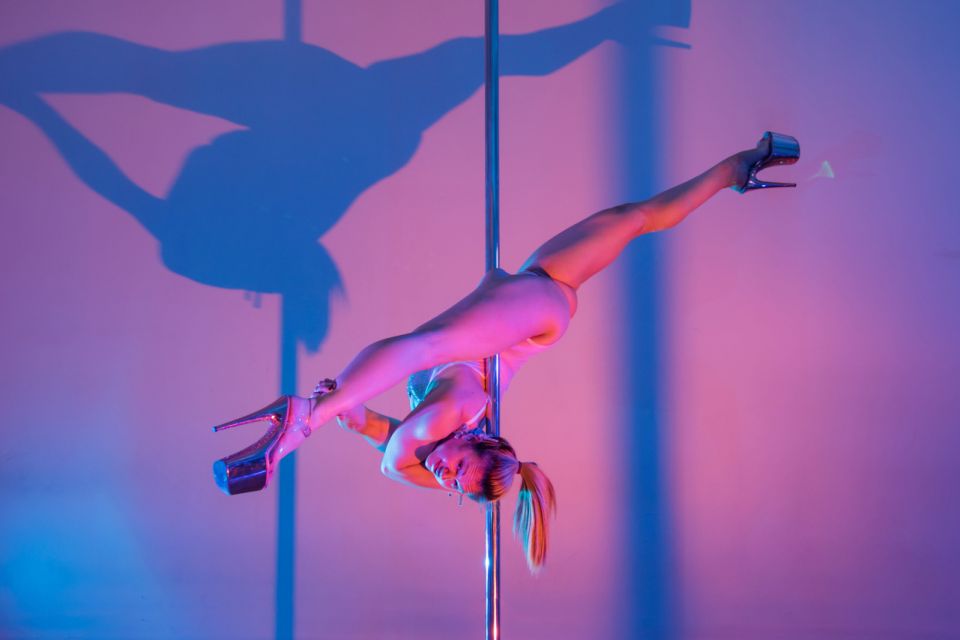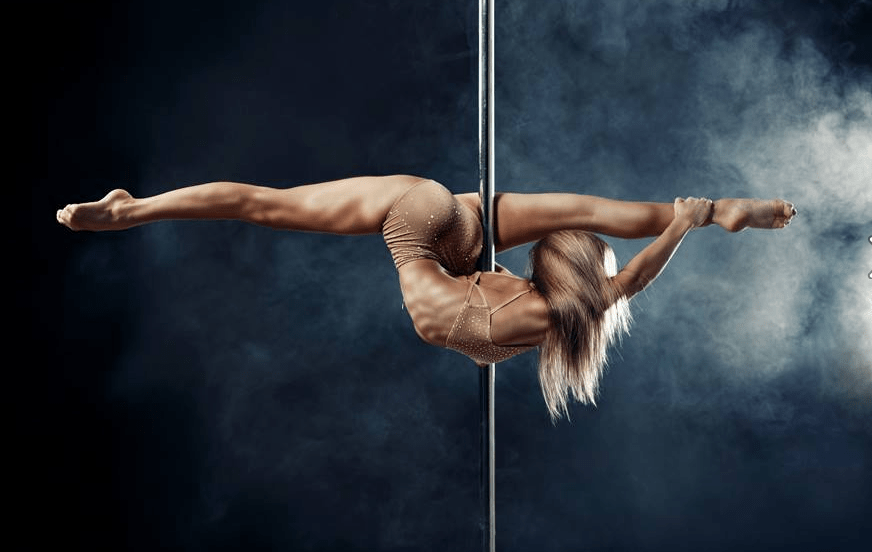Strip Down, Rise Up,” a documentary from Oscar-nominated director Michèle Ohayon, hits Netflix on Feb. 5. The opening scene is … sexy AF. A room full of women caress their bodies, toss their hair and bounce their asses against a wooden dance floor as candle lights flicker.
The rest of the film follows women from a diverse set of backgrounds into the world of pole dancing, a burgeoning sport and movement practice that many, myself included, find healing.
I am one of the women in “Strip Down, Rise Up.” I tell my story in the film: how I got into porn films in 2003 as a 20-year-old struggling actress in Los Angeles, and how after I got out of sex work, internet trolls harassed, stalked and doxxed me for years. I talk about how being harassed made me feel like I needed to constantly apologize, to play a woman who was sorry and regretful for her participation in sex work.
It’s worth noting here that porn was an industry that paid me well and treated me to a kind of transparency about work expectations that I have not seen in traditional workplaces. Not law, tech or hospitality.
Almost a decade after I left the porn industry, I discovered pole dancing, and it helped me to overcome that internalized shame. These spaces of fierce women’s empowerment became my safe place, a fortress from the societal scorn I suffered for a job choice I’d made long ago and didn’t actually regret.
Facing the judgment of those who consider sex work immoral was difficult. After my six-month stint in porn, I waitressed at two restaurants while taking 18 credit semesters at a community college. Men at the restaurants where I worked would recognize me from my movies. They’d make lewd comments or wait for me in the parking lot to ask me out or simply call me a whore.
In 2011, I began law school in Boston. Across the country, some 2,500 miles away from LA, I finally felt free of the past. But shortly after I started my first year, a patient database for a sexually transmitted infections testing center was hacked by anti-porn proponents, and the info was spilled on the internet.

It was eight years since my stint in porn. The site linked my performer name to my legal name. It published my family’s home address and other personally identifying information. I was grateful that it hadn’t caught up to my Boston apartment number. I also reminded myself that it still could.
Meanwhile, I kept my head down. I mostly studied and went on morning runs along the Charles River at sunrise. As fall turned to winter, bringing subzero temperatures, the morning runs got too cold. I still wanted to exercise so I got a Groupon deal to try pole dancing classes.
In the basement of a Gold’s Gym across the street from Fenway Park, I watched women with commercially imperfect bodies dance confidently, stripping down most of their clothes to reveal abs with stretch marks and jiggly thighs that they clearly felt great about. I wanted that kind of confidence in my body, too.
For the next three years, I’d finish studying at the law library around 6 p.m. and then bike to pole class. Over time, the women I trained with ― Rachel, a doctor, Julia, a chemist, and Samantha, a stripper and my pole dance teacher ― became my closest friends. We created pole routines together on weekends, spending hours in the studio. For my first year and a half, things went great ― I was building my new life as a legal student and putting my former porn life behind me.
One day during my second year, my law school friend Marjan pulled me aside after criminal law class. “Hey, this is uncomfortable,” she started. Somehow I already knew what she was going to say.
“A reporter contacted me on Facebook. He says he’s doing an exposé about a porn star going to Boston University. He says it’s you. He sent me a one-minute video of footage. Other people from our class got the message too.”
The shame I’d pushed down bubbled to the surface. I thought I had to be ashamed about my past to be a part of respectable society again. When I went to pole class that night, my eyes were rimmed red from tears.
“Where’s your smile, baby?” Rachel asked in her thick South Boston accent. I laughed. It was the same question porn directors used to ask when I was tired on set. I took a deep breath and told her about the threat of the exposé.
Rachel frowned as she took it all in. “But … who cares,” she said. It was a statement, not a question. For the first time, I felt fully seen ― not as a bad woman who needed to hide her sins, but as a big-hearted person with a deep-bellied laugh, a good friend, a woman whose sex work was the least interesting part of her.
Soon, Sam hugged me from the side. I inhaled the scent of her expensive shampoo and rested my chin on her bony shoulder. “Forget those people,” she said. In that moment, I realized that I’d found my community, that this was where I belonged.
One of the most powerful parts of “Strip Down, Rise Up” is when a succession of pole dance students talk about how their bodies did not feel like their own after they were sexually assaulted.
One woman tells her story about how as a teenager, she was one of hundreds of gymnasts assaulted by trusted and renowned medical doctor Larry Nasser. Other survivors speak to how pole dancing and exploring sensual movement has helped them to redefine their ownership of their bodies after it was seemingly taken from them by their assaults. One woman says pole dance and sensual movement feels like a release, a letting-go. Others say it feels like the dance embodies them, like something they live in.
For me, pole dancing feels like flying. Sometimes I almost am, as I sweep my body upside down around the pole. I love the sound of my friends gasping with fear when I do a new trick. I love the way my hair lifts behind me when I spin really fast and how it feels like jumping off the edge of a cliff. I love the feeling of my breath and heart in my throat when I perform a drop split.
For others, pole dance is about sensual movement, a way to reconceptualize what desire, strength and body acceptance feel like when the male gaze (what many people think of when they think of pole dancing) is not present or considered.
After graduating from law school and becoming an attorney, I worked in tech, ran a private law practice and now run three pole studios. At each of my studios, I’ve met so many people who come to heal from something; body image challenges, sexual assault, a general sense of their bodies not belonging to them.
Pole dancing uses the sensuality and strength inherent in the movement practice ― which was largely developed by strippers, though they are generally not given due credit ― as a way to reclaim autonomy over our bodies. In the five years I’ve run and built these studios and the communities inside them, I’ve come to understand that so many people ― not just women ― hold sexual shame as a kind of skeleton in their proverbial closets.
So many people have written to tell me about their experiences with shame; sex work shame, assault shame, rape shame, religious shame. So many people, so many shades of shame ― and so few spaces to explore sensuality in a way that is unashamed, unapologetic, and for one’s own pleasure and self-exploration.
Pole dance communities are havens around the world. The studios offer safe places for what the rest of the world seemingly doesn’t: the discovery of one’s sensuality and sexuality, which is a natural and necessary component of people’s identities that, for most, is left largely unexplored. “Strip Down, Rise Up” takes viewers along on a few of those journeys.
yahoo





